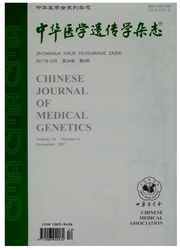

 中文摘要:
中文摘要:
目的在5个软骨发育异常家系中进行致病突变检测,并在明确突变的基础上建立针对热点致病突变的快速检测方法。方法酚-氯仿法提取先证者及家系成员外周血基因组DNA;用PcR—Sanger测序技术对5例先证者的FGFR3基因外显子及外显子/内含子衔接区序列进行突变分析;继而针对突变热点建立高分辨率熔解曲线(high resolution melting,HRM)检测方法。结果经直接测序确认4例先证者存在FGFR3基因第8外显子的c.1138G〉A(P.Gly380Arg)杂合突变,另外1例先证者存在FGFR3基因第11外显子内的C.1620C〉G(P.Asn540Lys)杂合突变;所有5例先证者HRM分析结果与测序结果一致。并对家系中胎儿进行了产前基因诊断。结论FGFR3基因的Gly380Arg和Asn540Lys突变是软骨发育不全/不良相关热点致病突变,在明确患者致病突变的基础上建立的基于PCR—HRM的突变热点的快速基因诊断方法,为该病的快速产前基因诊断奠定了方法学基础。
 英文摘要:
英文摘要:
Objective To identify the causative mutations in five individuals affected with dyschondroplasia and develop an efficient procedure for detecting hot spot mutations of the FGFR3 gene. Methods Genomic DNA was extracted from peripheral blood samples with a standard phenol/chloroform method. PCR-Sanger sequencing was used to analyze the causative mutations in the five probands. PCR - high resolution melting (HRM) was developed to detect the identified mutations. Results A c. 1138G〉A mutation in exon 8 was found in 4 probands, while a c. 1620C〉G mutation was found in exon 11 of proband 5 whom had a mild phenotype. All patients were successfully distinguished from healthy controls with the PCR-HRM method. The results of HRM analysis were highly consistent with that of Sanger sequencing. Conclusion The Gly380Arg and Asn540Lys are hot spot mutations of the FGFR3 gene among patients with ACH/HCH. PCR-HRM analysis is more efficient for detecting hot spot mutations of the FGFR3 gene.
 同期刊论文项目
同期刊论文项目
 同项目期刊论文
同项目期刊论文
 期刊信息
期刊信息
